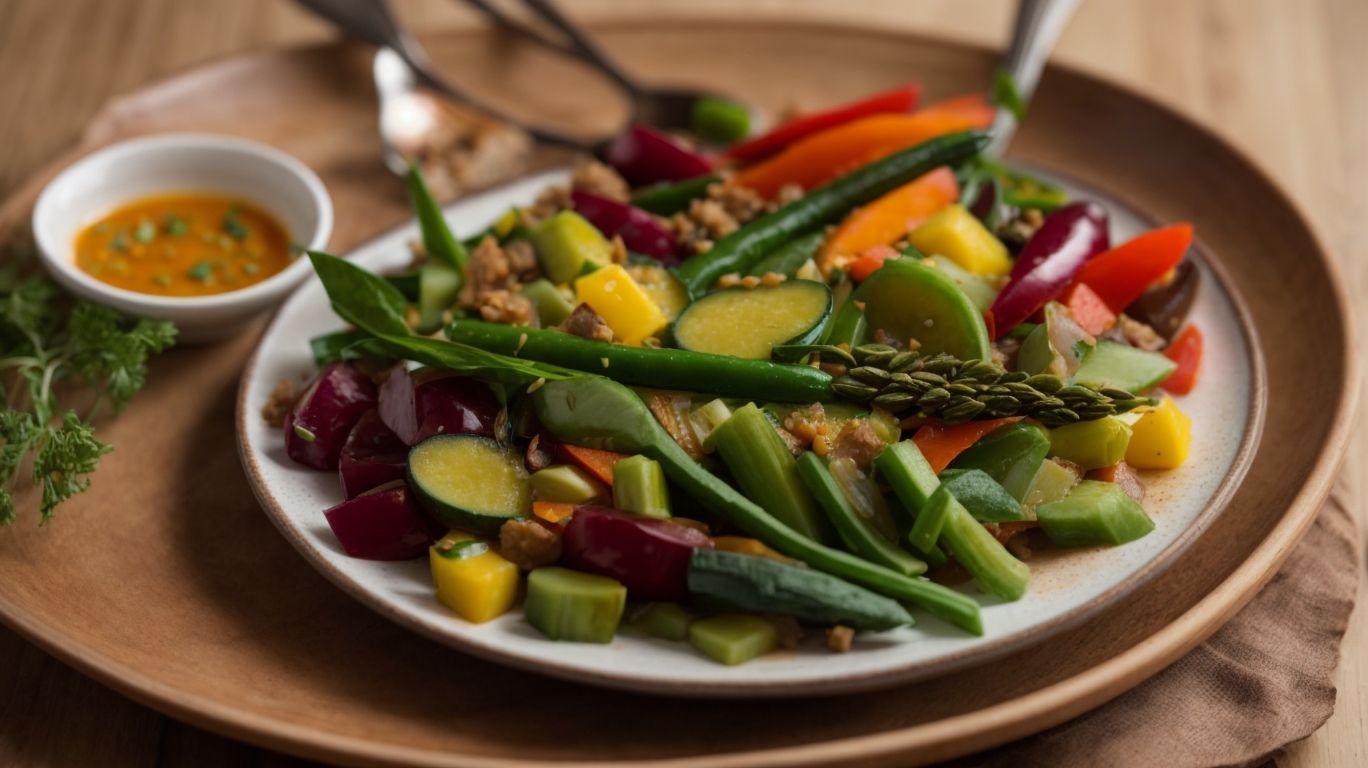How to Cook Pinakbet Without Meat?
Have you ever heard of the delicious Filipino dish called Pinakbet?
Originating from the northern regions of the Philippines, this savory vegetable medley is a popular choice for both vegetarians and meat-eaters alike.
We will explore the traditional ingredients of Pinakbet, its health benefits, different variations, and how to cook it without meat.
Whether you’re a fan of Filipino cuisine or looking to experiment with new flavors, stay tuned for some mouthwatering tips and tricks for making the perfect meatless Pinakbet.
Key Takeaways:
What is Pinakbet?
Pinakbet is a traditional Filipino vegetable stew known for its rich flavors and cultural significance in Filipino cuisine.
Considered a staple dish across the Philippines, Pinakbet boasts a delightful medley of vegetables such as ampalaya (bitter melon), okra, eggplant, and string beans, all simmered together with savory flavors of fermented shrimp paste known as bagoong. This dish reflects the ingenuity of Filipino cuisine by artfully combining various textures and tastes into a harmonious blend.
In the Ilocos region, Pinakbet is traditionally cooked in a clay pot over an open flame, enhancing its rustic charm and earthy flavors. The use of fresh ingredients from local markets adds to the authenticity and depth of flavor in this beloved Filipino dish.
Origin of Pinakbet
Pinakbet originates from the Ilocos Region of the Philippines, where it is deeply rooted in local traditions and culinary practices.
This traditional Filipino dish has a rich historical significance, reflecting the indigenous cooking techniques and ingredients of the region. The dish typically consists of a flavorful medley of vegetables such as ampalaya (bitter melon), okra, eggplant, squash, and string beans, often combined with shrimp paste or bagoong for a robust umami flavor. The method of cooking involves stewing or sautéing the vegetables with the bagoong, resulting in a savory and aromatic dish.
Pinakbet’s roots can be traced back to the pre-colonial era, showcasing the resourcefulness of Filipino cuisine in incorporating locally available ingredients. The dish embodies the essence of Filipino communal dining, symbolizing unity, sharing, and the joyful celebration of flavors.
Ingredients of Traditional Pinakbet
Traditional Pinakbet typically includes a medley of fresh vegetables such as eggplant, okra, and bitter melon, seasoned with aromatic garlic, onions, and the essential touch of bagoong or shrimp paste.
Aside from the vegetables and seasonings mentioned, Pinakbet also incorporates squash, string beans, and tomato, adding a vibrant array of colors and textures to the dish. The mix of flavors in Pinakbet is further enriched by the unique taste of ampalaya, a type of bitter gourd that lends a distinct bitterness to the dish, balancing out the sweetness of the other ingredients.
Pinakbet, a dish originating from the Ilocos region in the Philippines, embodies the flavors of the tropical climate with its use of fresh, locally-sourced produce. While various versions of Pinakbet exist across the Philippines, the core ingredients like bagoong and the emphasis on vegetables remain consistent, showcasing the rich culinary heritage of the country.
What Makes Pinakbet a Popular Dish?
Pinakbet’s popularity stems from its versatility as a flavorful and nutritious Filipino dish enjoyed in households across the country, catering to both meat-eaters and vegans alike.
Pinakbet’s unique ability to accommodate various dietary preferences has allowed it to become a household favorite, with each region in the Philippines infusing its own twist to the dish.
This dish not only reflects Filipino cooking traditions but also embodies the warmth and comfort of family meals shared around the table, creating a sense of togetherness and community.
Its simple yet robust flavors, thanks to the mix of vegetables like eggplant, squash, and bitter melon, paired with the umami goodness of shrimp paste or fish sauce, make it a truly satisfying meal.
Health Benefits of Pinakbet
Pinakbet offers a myriad of health benefits due to its emphasis on fresh vegetables, coconut cream for added richness, making it a popular choice among vegans and health-conscious individuals seeking a nutritious meal.
Vegetables like ampalaya, sitaw, kalabasa, and okra are packed with essential vitamins, minerals, and dietary fiber that support overall well-being and digestive health. The use of coconut cream not only adds a creamy texture but also provides a dairy-free alternative, perfect for those with lactose intolerance or following a vegan or vegetarian lifestyle.
This Filipino vegetable dish showcases the rich diversity of plant-based ingredients and how they can be combined to create a delicious and satisfying meal. With its vibrant colors, robust flavors, and nutrient-dense components, Pinakbet truly exemplifies the art of plant-based cuisine in Filipino gastronomy.
Variations of Pinakbet
Pinakbet offers a canvas for culinary creativity with a range of recipe variations and cooking tips that cater to different tastes and preferences, allowing for a personalized touch to this beloved Filipino dish.
From the mountains of the Cordillera region to the coastal areas of Ilocos, each locality adds its unique twist to Pinakbet, ensuring its widespread popularity across the Philippines. In some versions, shrimp paste or bagoong is used for a more intense umami flavor, while others opt for a vegetarian take with a medley of fresh vegetables. The cooking techniques vary too – some prefer a slow simmer for a deeper melding of flavors, whereas others emphasize quick stir-frying to retain the vegetables’ crunchiness.
How to Cook Pinakbet Without Meat?
Cooking Pinakbet without meat involves using clever substitutes such as tofu, mushrooms, or additional umami-rich ingredients like fermented fish sauce to enhance the dish’s savory profile.
When opting for tofu as a meat replacement, consider using extra-firm tofu that has been well-pressed to achieve a firmer texture conducive to stir-frying in the dish. By marinating the tofu in a mixture of soy sauce, garlic, and vegan fish sauce before cooking, you can infuse it with delightful flavors akin to traditional Filipino cuisine.
Mushrooms add a hearty, meaty texture to the Pinakbet, particularly varieties like shiitake or oyster mushrooms that impart a rich umami taste. Quickly searing the mushrooms in a hot pan before incorporating them into the vegetable medley can enhance their flavor and mimic the depth that meat provides.
Substitutes for Meat in Pinakbet
When replacing meat in Pinakbet, options like anchovies or salt can provide the desired umami flavor and depth to the dish, ensuring a satisfying culinary experience without compromising on taste.
Using anchovies in Pinakbet can give the dish a rich, savory undertone that complements the assortment of vegetables. The umami-packed flavor of anchovies infuses into the broth, enhancing the overall taste profile while adding a unique seafood element.
Alternatively, for those looking to limit fishiness, salt can be used judiciously to season the dish, balancing the flavors without overwhelming the natural sweetness of the vegetables. The careful selection of seasonings is crucial in Pinakbet, where each ingredient plays a significant role in creating a harmonious and delectable blend.
Step-by-Step Instructions for Cooking Meatless Pinakbet
Prepare a delicious meatless Pinakbet by following these step-by-step instructions, incorporating a medley of fresh vegetables, seasonings, and cooking techniques to create a flavorful and satisfying dish.
Pinakbet is a popular Filipino vegetable stew that typically includes ingredients like bitter melon, eggplant, squash, okra, and string beans simmered in a savory shrimp paste sauce.
To start, gather your vegetables and chop them into bite-sized pieces for even cooking. The key to a delicious Pinakbet lies in the balance of flavors and textures, so ensure to mix a variety of vegetables.
Heat some oil in a pan and sauté garlic, onions, and tomatoes until fragrant. Add in your prepared veggies and cook them until slightly tender.
A crucial step in making traditional Pinakbet is the addition of bagoong, a fermented shrimp paste that adds a unique umami flavor to the dish.
Tips for Making the Perfect Meatless Pinakbet

Credits: Poormet.Com – Walter Scott
Achieve the perfect balance of flavors and textures in your meatless Pinakbet by selecting fresh bitter melon, incorporating traditional Filipino ingredients, and embracing the evolving nature of Filipino recipe traditions.
When preparing your meatless Pinakbet, ensure that the bitter melon you choose is firm and vibrant in color to guarantee optimal taste and texture for your dish. It is essential to slice the bitter melon thinly to help reduce its inherent bitterness, making it more palatable for those new to this unique vegetable.
To enhance the traditional Filipino flavors in your Pinakbet, consider incorporating classic ingredients such as eggplant, squash, and green beans, which contribute to the dish’s authenticity and overall deliciousness.
To truly embrace the evolving nature of Filipino culinary traditions, feel free to experiment with modern twists on the traditional Pinakbet recipe, such as adding tofu or incorporating alternative seasonings for a personalized touch.
Choosing the Right Vegetables
Selecting the appropriate mix of Filipino vegetables such as sweet potatoes, squash, and bitter melon is essential for capturing the authentic flavors and textures in your Pinakbet, reflecting the rich culinary tradition of the Philippines.
These quintessential ingredients not only add a burst of color to your dish but also bring a depth of taste that is unique to Filipino cuisine. Sweet potatoes, known locally as ‘kamote,’ provide a subtle sweetness and hearty texture, while squash, or ‘kalabasa,’ imparts a creamy richness that balances the dish’s flavor profile.
The inclusion of bitter melon, locally referred to as ‘ampalaya,’ adds a pleasant bitterness that complements the other ingredients and enhances the overall gastronomic experience.
Proper Cooking Techniques
Mastering the proper cooking techniques, such as stir-frying long green beans and simmering the stew to meld flavors, is crucial for achieving the authentic taste and texture of Pinakbet, a beloved Filipino stew.
When stir-frying the long green beans, it’s essential to retain their crispiness and vibrant green color to add a delightful crunch to the dish.
The simmering process, on the other hand, allows the flavors of shrimp paste, garlic, and tomatoes to infuse into the vegetables like eggplant and bitter melon, creating a harmonious blend of savory and slightly bitter notes.
These distinct cooking methods emphasize the importance of patience and attention to detail in Filipino cuisine, where every ingredient contributes to the overall complexity of the dish.
Seasoning and Flavoring Tips
Infuse your Pinakbet with authentic flavors by seasoning it with traditional ingredients like dashi, accentuating the natural taste of fresh okra and paying homage to the culinary heritage of the Ilocos Region.
Pinakbet, a beloved Filipino dish originating from the northern province of Ilocos, is a true reflection of the region’s rich culinary traditions.
When preparing Pinakbet, it’s essential to incorporate the distinctive flavors of the Ilocos Region by using local ingredients such as bagoong (fermented fish paste), ampalaya (bitter melon), and sitaw (long beans).
The addition of dashi, a Japanese soup stock known for its umami richness, elevates the dish to a new level, adding depth and complexity to the flavors.
Conclusion

Credits: Poormet.Com – Bruce Thomas
In conclusion, Pinakbet stands as a quintessential Filipino recipe that embodies the rich culinary heritage and diverse flavors of Filipino cuisine, reflecting the cultural tapestry and communal traditions of Filipino households.
Originating from the Ilocos region in the Philippines, Pinakbet is a vegetable dish that showcases a harmonious blend of flavors and textures, reflecting the agricultural abundance of the region. This iconic dish typically features a medley of vegetables like eggplant, okra, bitter melon, and string beans, cooked with shrimp paste and a hint of pork for added depth of flavor.
What truly sets Pinakbet apart is its unique cooking technique, where the vegetables are sautéed and simmered together, allowing them to meld flavors and create a wholesome dish that is both nutritious and flavorful. Traditionally, Pinakbet is enjoyed family-style, with everyone sharing a communal plate, reinforcing the value of togetherness and kinship in Filipino culture.
Frequently Asked Questions
How to Cook Pinakbet Without Meat?
What is pinakbet?
Pinakbet is a popular Filipino dish made with mixed vegetables and shrimp paste.
How to Cook Pinakbet Without Meat?
Can pinakbet be made without meat?
Yes, pinakbet can be made without meat by using alternative protein sources like tofu or tempeh.
How to Cook Pinakbet Without Meat?
What vegetables are typically used in pinakbet?
Eggplant, squash, okra, bitter melon, and string beans are commonly used in pinakbet.
How to Cook Pinakbet Without Meat?
What is a good substitute for shrimp paste in pinakbet?
You can use fermented soybean paste or fish sauce as a substitute for shrimp paste in pinakbet.
How to Cook Pinakbet Without Meat?
Is pinakbet a vegan-friendly dish?
It can be made vegan-friendly by omitting any animal-derived ingredients and using vegetable-based alternatives.
How to Cook Pinakbet Without Meat?
Can I freeze pinakbet?
Yes, pinakbet can be frozen for later consumption. Just make sure to thaw it properly before reheating.




